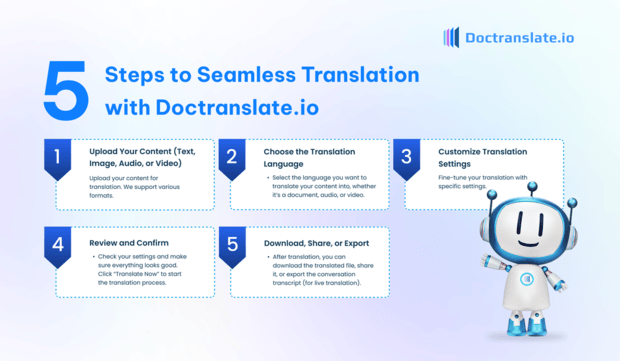Introduction
Translating software strings is crucial for global reach. It allows your application to connect with users across different linguistic backgrounds effectively. Breaking down language barriers is key to expanding your market.
For businesses targeting an English-speaking audience, translating from languages like Traditional Chinese is a necessary step. This ensures your software is accessible and user-friendly worldwide.
Doctranslate.io provides a streamlined and efficient solution for this complex task. It simplifies the process of translating various content types, including documents containing software strings.
This guide will walk you through translating your software strings from Traditional Chinese to English. You will use Doctranslate.io‘s powerful features for accuracy and ease.
Step-by-Step Guide: Translating Software Strings from Traditional Chinese to English with Doctranslate.io
Step 1: Prepare and Upload Your Content
Software strings are often organized in specific file formats. Ensure your strings are in a document supported by Doctranslate.io.
Supported formats include common types like Word (.docx), Excel (.xlsx, .xls), PDF, and PowerPoint (.pptx). Prepare your Traditional Chinese strings within one of these file types.
Navigate to the Doctranslate.io Document Translation page. You can easily upload your prepared file there.
Simply drag and drop your document into the designated area. Doctranslate.io makes the upload process quick and intuitive for documents.
Step 2: Choose the Translation Language
Once your Traditional Chinese document is uploaded, select the desired output language. For software strings targeting a global audience, English is a primary choice.
Find the language selection dropdown on the interface. Scroll through the list of supported languages available on Doctranslate.io.
Select ‘English’ as your target language from the options provided. This tells the system to translate your Traditional Chinese strings into English.
Doctranslate.io supports over 85 languages, offering flexibility for various translation needs beyond Traditional Chinese and English.
Step 3: Customize Your Translation Settings
To ensure your software strings are translated accurately and contextually, Doctranslate.io offers customization options. This is vital for maintaining the correct tone and terminology.
Customize settings like the translation ‘tone’ and ‘domain’. Choosing the right domain, like ‘IT’ or ‘Software,’ helps refine terminology for better accuracy.
Utilize the ‘My Dictionary’ feature. This allows you to add specific technical terms or brand names to ensure consistent translation throughout your software strings.
These customization options help maintain the original intent and technical accuracy of your Traditional Chinese software strings when translating them into English. Visit the Document Translation page for details.
Step 4: Review and Confirm
Before initiating the translation, take a moment to review your settings. Check that the source language is Traditional Chinese and the target is English.
Confirm any customization options you selected are correct. This includes checking your chosen tone, domain, and My Dictionary entries if used.
Ensure the uploaded document is the correct one containing your software strings. A quick check prevents accidental translation of the wrong file.
Once you are satisfied with all the settings, click the ‘Translate Now’ button. Doctranslate.io will then begin processing your request.
Step 5: Download Your Translated Document
After the translation process is complete, Doctranslate.io will notify you. Your translated document containing the English software strings will be ready.
You will be prompted to download the translated file directly to your computer. The original document format and layout are typically preserved.
This feature is particularly useful for documents like Excel files used for managing software strings. The structure remains intact for easy integration.
Download the file and review the translated strings. You can then integrate the English text into your software development process seamlessly.

Conclusion
Translating software strings from Traditional Chinese to English is made straightforward with Doctranslate.io. The platform handles the process efficiently, preserving document structure.
By following these simple steps—uploading, selecting languages, customizing, reviewing, and downloading—you can achieve accurate translations. This is crucial for software localization.
Doctranslate.io‘s support for various document types and features like ‘My Dictionary’ ensures high-quality output tailored to your specific needs.
Start translating your software strings today. Experience the benefits of reaching a wider, English-speaking audience with professional and accurate translations. Visit DocTranslate.io to get started!


Leave a Reply